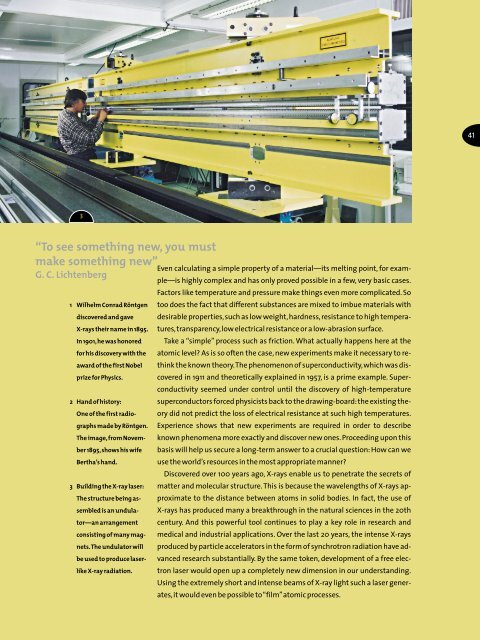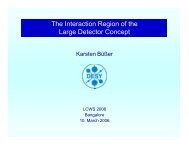TESLA Brochure - ACFA Joint Linear Collider Physics and Detector ...
TESLA Brochure - ACFA Joint Linear Collider Physics and Detector ...
TESLA Brochure - ACFA Joint Linear Collider Physics and Detector ...
You also want an ePaper? Increase the reach of your titles
YUMPU automatically turns print PDFs into web optimized ePapers that Google loves.
3<br />
“To see something new, you must<br />
make something new”<br />
G. C. Lichtenberg<br />
1 Wilhelm Conrad Röntgen<br />
discovered <strong>and</strong> gave<br />
X-rays their name in 1895.<br />
In 1901,he was honored<br />
for his discovery with the<br />
award of the first Nobel<br />
prize for <strong>Physics</strong>.<br />
2 H<strong>and</strong> of history:<br />
One of the first radiographs<br />
made by Röntgen.<br />
The image,from November<br />
1895,shows his wife<br />
Bertha’s h<strong>and</strong>.<br />
3 Building the X-ray laser:<br />
The structure being assembled<br />
is an undulator—an<br />
arrangement<br />
consisting of many magnets.The<br />
undulator will<br />
be used to produce laserlike<br />
X-ray radiation.<br />
Even calculating a simple property of a material—its melting point, for example—is<br />
highly complex <strong>and</strong> has only proved possible in a few, very basic cases.<br />
Factors like temperature <strong>and</strong> pressure make things even more complicated. So<br />
too does the fact that different substances are mixed to imbue materials with<br />
desirable properties,such as low weight,hardness,resistance to high temperatures,transparency,low<br />
electrical resistance or a low-abrasion surface.<br />
Take a “simple” process such as friction. What actually happens here at the<br />
atomic level? As is so often the case, new experiments make it necessary to rethink<br />
the known theory.The phenomenon of superconductivity,which was discovered<br />
in 1911 <strong>and</strong> theoretically explained in 1957, is a prime example. Superconductivity<br />
seemed under control until the discovery of high-temperature<br />
superconductors forced physicists back to the drawing-board:the existing theory<br />
did not predict the loss of electrical resistance at such high temperatures.<br />
Experience shows that new experiments are required in order to describe<br />
known phenomena more exactly <strong>and</strong> discover new ones. Proceeding upon this<br />
basis will help us secure a long-term answer to a crucial question: How can we<br />
use the world’s resources in the most appropriate manner?<br />
Discovered over 100 years ago, X-rays enable us to penetrate the secrets of<br />
matter <strong>and</strong> molecular structure. This is because the wavelengths of X-rays approximate<br />
to the distance between atoms in solid bodies. In fact, the use of<br />
X-rays has produced many a breakthrough in the natural sciences in the 20th<br />
century. And this powerful tool continues to play a key role in research <strong>and</strong><br />
medical <strong>and</strong> industrial applications. Over the last 20 years, the intense X-rays<br />
produced by particle accelerators in the form of synchrotron radiation have advanced<br />
research substantially. By the same token, development of a free electron<br />
laser would open up a completely new dimension in our underst<strong>and</strong>ing.<br />
Using the extremely short <strong>and</strong> intense beams of X-ray light such a laser generates,it<br />
would even be possible to “film”atomic processes.<br />
41




